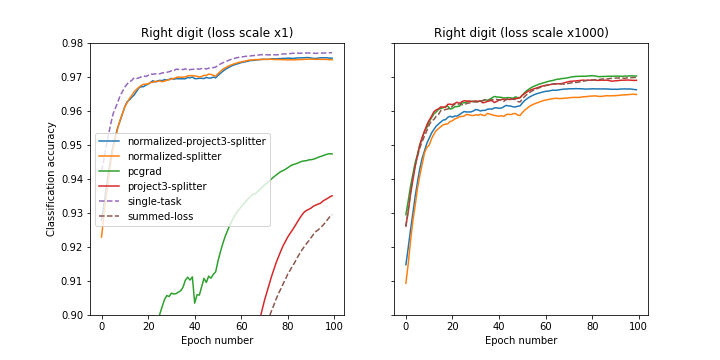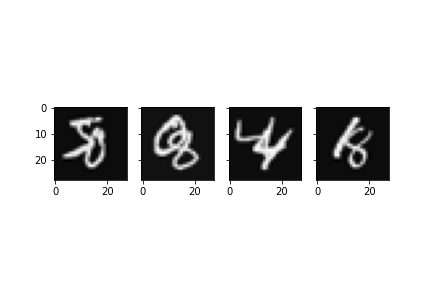A simple deep learning solution for multitask in PyTorch.
You can copy-paste the standalone file splitter.py or clone the repo and do pip install .
The main class is Splitter class is used as follows:
from torchmultitask.splitter import NormalizedMultiTaskSplitter
# set the weight of each task, no need to take into account the different scales of the loss function.
# typically 1.0 is a one-size-fits-all that avoids fine-tuning the loss weights (weights between 0.1 and 10 can be tried out, to prioritize one loss)
task_weight_dict = {"task_1": 1.0, "task_2": 1.0}
splitter = NormalizedMultiTaskSplitter(task_weight_dict)
for x in dataloader:
x = base_model(x)
x_dict = splitter(x) # identity in the forward pass but normalizes and project gradients in the backward pass.
loss1 = loss_model1(x_dict["task_1"])
loss2 = loss_model2(x_dict["task_2"])
loss = loss1 + loss2
loss.backward()
... # can be used with any pytorch optimizer1) Gradient normalization: The first trick is to normalization gradients similarly as in Meta's multitask normalizer [3].
An important difference is that it's implemented here with a custom autograd.Funcion to override the backward pass.
This enables splitting gradients anywhere in the computational graph unlike with Meta's implementation (here).
In short each gradient is normalization using:
def backward(grads, m):
# pseudo-code summary of GradientNormalizer(...) in gradient_normalizer.py
# the NormalizedMultiTaskSplitter(...) in splitter.py does it on all tasks simultaneously to go faster
m = beta * m + (1-beta) * grads.square().mean(0).sum() # momentum of the gradient norms, mean on batch dimension
v = m / (1 - torch.pow(beta,t) # unbiased momentum formula
return grads / v.sqrt().clip(min=epsilon) * loss_coeff # return the scalaed gradient2) Gradient projection: Inspired by pcgrad [1,4] and this nice paper [2] we also tried to project the gradients onto each other. This is disabled by default because it slows down the training a bit (by ~20%, still faster that the pytorch implementation [3]) in some cases it might improve performance.
Two digits are plotted and the two tasks are to classify digits 1 and 2. This is similar to the toy multi-task problem considered in [2]. The dataloader is debugged from the Pytorch-PCGrad repo and we compare our results to their implementations of pcgrad.
Demo on Multi MNIST: Two digits (left and right) are overlapping on an image. The image is processed with a LeNet ConvNet to produce features. The feature vector is sent into two MLPs to compute classification cross entropy losses for the left and right digit respectively.

Figure 1. Left: Classification accuracy for the left digit (averaged over 3 independent runs), the x-axis is the epoch number.
Right: Classification accuracy for the right digit.

Figure 2. Same as Figure 1, but without the re-weighted of the loss functions, there are already balanced and the normalization has a weaker effect.
Cite this repo:
@misc{bellec2023,
author = {Bellec, G},
title = {Multi-task splitter: A simple deep learning solution for multitask in PyTorch},
year = {2023},
journal = {GitHub repository},
howpublished = {\url{https://github.com/guillaumeBellec/multitask}}
}Related references:
[1] Gradient Surgery for Multi-Task Learning (pcgrad)
Tianhe Yu, Saurabh Kumar, Abhishek Gupta, Sergey Levine, Karol Hausman, Chelsea Finn
[2] Multi-Task Learning as Multi-Objective Optimization
Ozan Sener, Vladlen Koltun
[3] High Fidelity Neural Audio Compression
Alexandre Défossez, Jade Copet, Gabriel Synnaeve, Yossi Adi
[4] Unofficial pytorch pcgrad repository
github.com/WeiChengTseng/Pytorch-PCGrad.git
